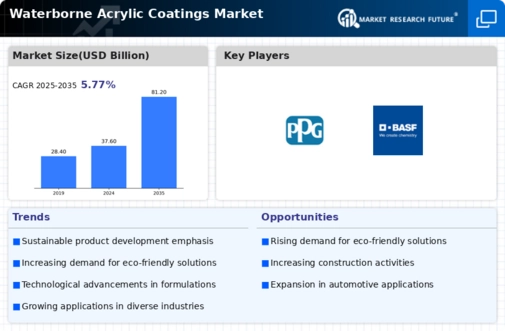Acrylic Based Waterborne Coatings Size
Acrylic Based Waterborne Coatings Market Growth Projections and Opportunities
The waterborne acrylic coating market is influenced by various market factors that shape its dynamics and growth trajectory. One of the key factors driving this market is the increasing demand for environmentally friendly coatings. With growing concerns about environmental sustainability and regulations aimed at reducing volatile organic compound (VOC) emissions, waterborne acrylic coatings have emerged as a popular choice due to their lower VOC content compared to solvent-based alternatives. This shift towards eco-friendly coatings is driven by both consumer preferences for greener products and regulatory mandates promoting sustainable practices.
Waterborne Acrylic coatings are environmentally friendly coatings that are used to treat surfaces of different materials whose basic medium of solvent is water. Water-soluble resins are used in the development and application of these coatings. The common water-soluble resins used are alkyds, acrylics, styrene-butadiene copolymers, and others. Due to the release of low-level Volatile Organic Compounds (VOCs) when water-based resins are used, waterborne coatings are preferred over solvent-borne coatings as they have a comparatively negligible amount of environmental impact.
Additionally, the construction industry plays a significant role in driving the demand for waterborne acrylic coatings. As urbanization continues to expand globally, there is a rising need for high-performance coatings to protect and enhance various construction materials, such as concrete, metal, and wood. Waterborne acrylic coatings offer excellent durability, weather resistance, and adhesion properties, making them suitable for a wide range of applications in architectural coatings, industrial coatings, and infrastructure projects. The growing construction activities in emerging economies, coupled with renovation projects in developed regions, contribute to the market's expansion.
Moreover, technological advancements and innovations in formulation techniques are driving market growth by improving the performance and versatility of waterborne acrylic coatings. Manufacturers are investing in research and development to enhance product properties such as durability, scratch resistance, and faster drying times. These advancements not only broaden the application scope of waterborne acrylic coatings but also contribute to their competitiveness against traditional solvent-based coatings. Additionally, innovations in nanotechnology have led to the development of nanocoatings, which further enhance the performance and functionality of waterborne acrylic coatings in specialized applications.
Market factors such as raw material prices and supply chain dynamics also impact the waterborne acrylic coating market. Fluctuations in the prices of raw materials, including acrylic resins, pigments, and additives, can influence production costs and ultimately affect product pricing and profitability for manufacturers. Moreover, the availability of raw materials and logistical challenges in the supply chain can impact the market's stability and competitiveness, particularly in regions with high demand growth and limited local production capacity.
Furthermore, regulatory factors and government policies play a significant role in shaping the waterborne acrylic coating market landscape. Stringent regulations aimed at reducing emissions and promoting sustainable manufacturing practices drive the adoption of waterborne coatings globally. Government initiatives to incentivize the use of eco-friendly coatings through tax incentives, subsidies, and procurement policies also stimulate market growth. Compliance with regulatory standards and certifications, such as LEED (Leadership in Energy and Environmental Design) and Green Seal, is increasingly becoming a prerequisite for suppliers and manufacturers to access markets and win contracts, further driving the demand for waterborne acrylic coatings.
Market dynamics such as competitive landscape and market consolidation also influence the waterborne acrylic coating market. The market is characterized by the presence of several key players competing based on product innovation, quality, pricing, and distribution network. Market consolidation through mergers, acquisitions, and partnerships is a common trend among leading manufacturers seeking to expand their product portfolios, geographic presence, and market share. Additionally, strategic collaborations with end-users and research institutions enable companies to gain insights into evolving customer needs and emerging technologies, fostering product development and market expansion initiatives.






Leave a Comment